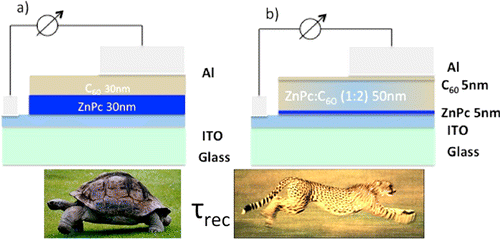Losses of charge carriers, due to the interfacial charge recombination processes, in small molecule organic solar cells (SMOSCs) have been investigated under operating conditions. The devices consist of zinc phthalocyanine (ZnPc) as electron donor material and C60 as electron acceptor. The results obtained by using time-resolved techniques such as charge extraction (CE) and photoinduced transient photovoltage (TPV) have been compared to the measurements carried out with impedance spectroscopy (IS) and show good agreement. Significantly, much difference is observed in either the charge density distribution versus the device voltage or the charge carriers lifetime when comparing bulk heterojunction versus bilayer-type ZnPc:C60 devices. The implications of the faster charge carrier recombination with the device fill factor (FF) and the open circuit voltage (VOC) are discussed.
